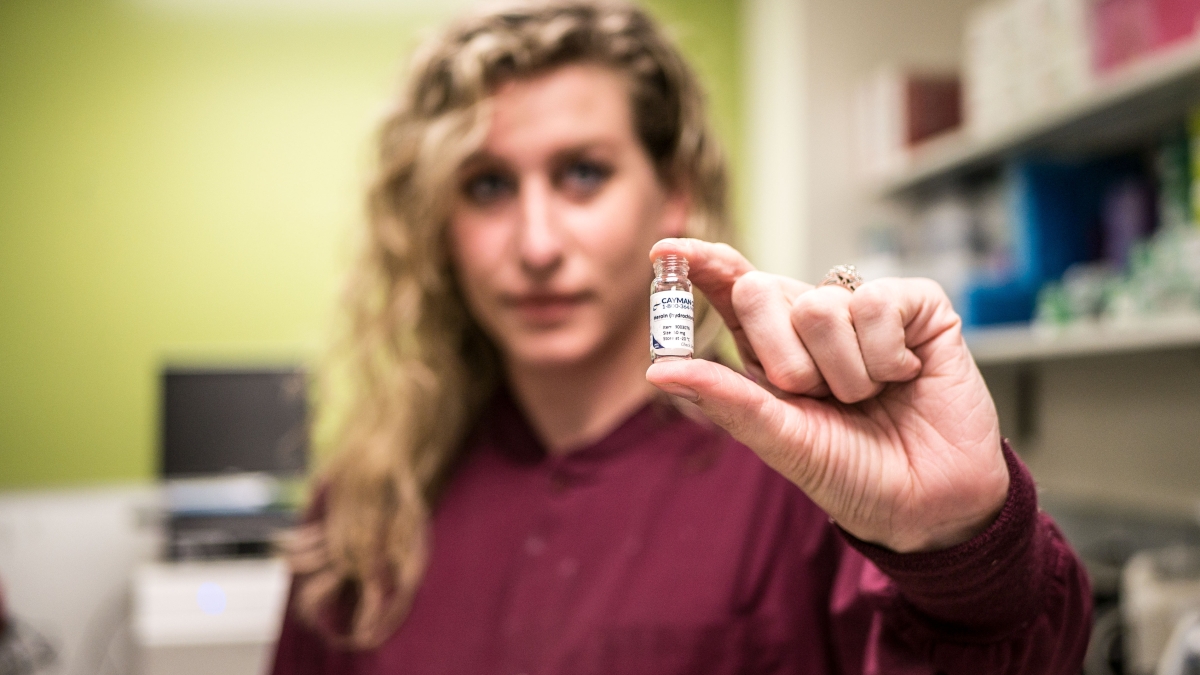Friendship is good, but opioids are better
New ASU study shows animals choose heroin over helping others

ASU psychology graduate student Seven Tomek found animals chose the opioid heroin, shown in the vial, instead of rescuing a trapped animal. Animals that were given sugar pellets continued to rescue trapped animals.
Each day in the United States, 116 people die from an opioid-related drug overdose. Opioid addiction has reach epidemic levels and is estimated to have cost the country $1 trillion since 2001. One of the criterion for opioid addiction is persistent or recurrent social or interpersonal problems as a result of opioid use, but the social influences on opioid addiction are just beginning to be studied.
Researchers in the Arizona State University Department of Psychology have shown that animals who have been trained to rescue a trapped animal stop helping when opioids are available, suggesting that animals have social deficits similar to the known social impairments in human opioid addiction. The study will be published in Addiction Biology, and an advance online copy was made available May 4.
“We found that the opioid heroin basically erased the prosocial behaviors of our subjects,” said Seven Tomek, a psychology graduate student and lead author on the study. Tomek works in the Addiction Neuroscience Laboratory, which is led by Associate Professor Foster Olive.
Like a key in a lock, opioid drugs activate very specific receptors on neurons instead of the neurotransmitters naturally made by the brain. Some of the receptors that opioid drugs activate are responsible for creating pleasurable feelings and relieving pain. Though opioids only target a few specific receptors, these drugs can affect the entire brain, including in areas responsible for social interactions.
A need for an animal model of social deficits in opioid addiction
Tomek has a master’s degree in psychology, and she worked with patients receiving treatment for substance abuse.
“The main complaints of my opioid addicted patients were about social interactions and relationships,” she said. “When I read on the blog IFLScience about an experiment that tested social behaviors in animals by letting them choose whether or not to free a trapped animal, I immediately thought, ‘We need to test this with drugs!’”
In the experiment, one animal is trapped in a plastic tube. A second animal is then trained how to open the tube and free the trapped animal. Tomek convinced Olive to let her conduct the experiment with heroin. To get started, she contacted the developer of the animal rescue experiment, University of Chicago neuroscientist Peggy Mason, for details the lab needed to perform the experiment.
“The Mason paradigm is robust,” Tomek said. “Animals will routinely choose to rescue a trapped animal over a food treat, including chocolate.”
The value of helping a friend is greater than sugar but less than opioids
After training the animals how to open the tube and free the trapped animal, the researchers divided the animals into two groups. When the animals poked their nose into a special hole, one group was given sugar pellets to eat and the other group received intravenous heroin. The animals in the heroin group were allowed to receive up to 100 heroin infusions, each separated by a 20 second waiting period.
Animals in the sugar and heroin groups were then given 30 minutes to decide whether to rescue the trapped animal, to eat sugar or be injected with heroin, or to do both. The animals in the sugar group kept rescuing trapped animals, just like before. None of the animals in the heroin group rescued. They walked around and looked at the trapped animals without opening the door.
“Dysfunctional social relationships and social withdrawal add to the psychological strain of addiction, but we don’t know much about the effects of drug intake on social cognition. This pioneering paper is timely and might pave the way for more targeted and efficient rehabilitation and post-rehab treatment options,” said Tobias Kalenscher, professor of psychology at the Heinrich Heine University of Düsseldorf in Germany. “It is very important to know what it is about heroin that stopped the animals from prosocial behavior, and I hope future work begins to target the underlying brain mechanisms.”
Next, Tomek and Olive plan to test ways to restore social functioning in animals addicted to opioids, which could suggest new treatment options for dealing with the human opioid epidemic.
“These findings are very exciting, especially in light of the fact that the neurobiology of addiction is often scientifically investigated without accounting for important social influences,” Olive said. “In addition to identifying brain regions that are responsible for social deficits in opiate addiction, we also hope to eventually expand this line of research to other drugs that are consumed in social settings, such as alcohol, nicotine, stimulants and marijuana.”
Read the full study on Addiction Biology.
Written by Kim D'Ardenne
More Science and technology

ASU author puts the fun in preparing for the apocalypse
The idea of an apocalypse was once only the stuff of science fiction — like in “Dawn of the Dead” or “I Am Legend.” However…

Meet student researchers solving real-world challenges
Developing sustainable solar energy solutions, deploying fungi to support soils affected by wildfire, making space education more…

Miss Arizona, computer science major wants to inspire children to combine code and creativity
Editor’s note: This story is part of a series of profiles of notable spring 2024 graduates. “It’s bittersweet.” That’s how…